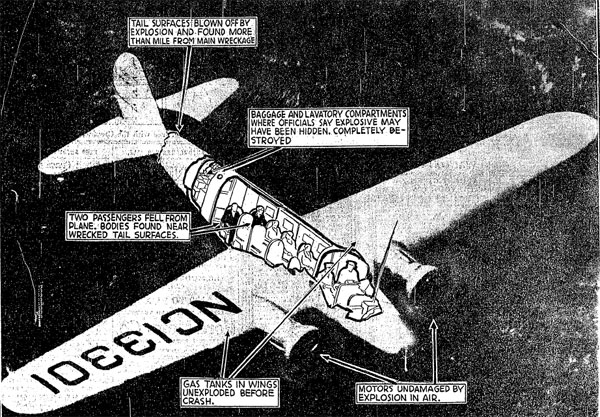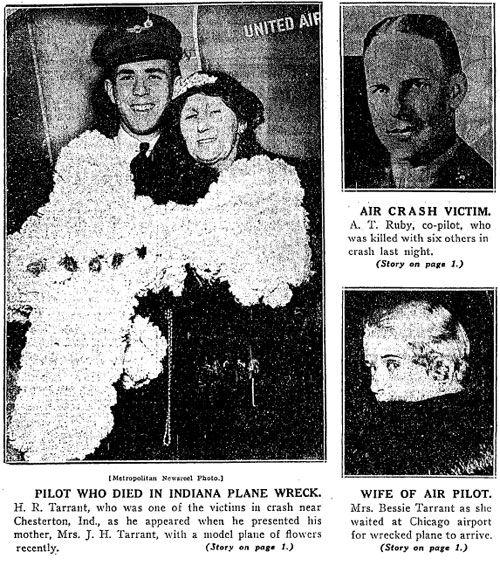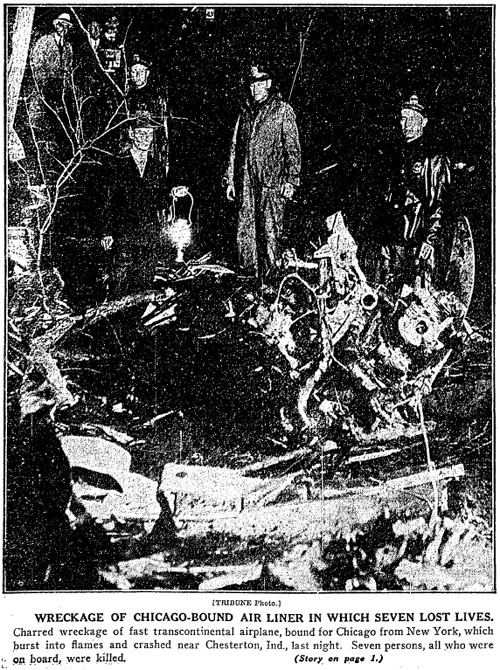
On the night of October 10, 1933, United Air Lines Flight 23, a ten-seater making its way from Newark to Chicago via Cleveland, with an eventual destination of Oakland, California, exploded over northwest Indiana and "shot to earth like a blazing comet before the horrified eyes of dozens of persons in the vicinity." It crashed five miles southeast of Chesterton, Indiana, killing seven: four passengers, two pilots, and a stewardess.
Thus began the history of American airline terrorism… or not. Almost 80 years later, the incident remains a mystery.
The pilot, 25-year-old Harold Tarrant, was a Winnetka native and New Trier grad, had lived through one front-page tragedy already: in 1928, Tarrant and three friends were sailing off of Evanston when their boat capsized. One of Tarrant’s friends drowned; the three survivors clung to the overturned boat for 15 hours before being rescued by the coast guard.
Tarrant, who had been with United for two years and was "considered one of the best pilots," was on time for a Chicago arrival when, at 8:45, a blast blew the tail off the plane:
"We were startled by a terrific explosion," said [James] Graff. "We ran outside. We saw the plane burning in air, about 1,000 feet up. It was falling like a rock, flames shooting out on all sides. It came down faster and faster. We could hear the motor running. The plane zigzagged as if in a tail spin.
"Then it hit the ground with a roar and a crash I hope to never hear again. Flames shot up at least 200 feet. I heard what I thought were people crying out. With Arndt I tried to throw water on the flames, but couldn’t get near enough to do any good. We had to stand on, helpless."
The zigzag was likely due to Tarrant’s attempt to land the plane with the one good motor; he was found 50 feet away, thrown clear from the crash.

The Tribune‘s report the next day, October 11, cited county officials who "believed that one of the motors or a gasoline tank blew up." By the 12th, "aviation authorities" had advanced a couple theories: a broken gas line ignited by an exhaust pipe, and a supercharger impeller exploding from metal fatigue.
The next day brought a shock: news that Department of Commerce officials were denying any evidence that a "time bomb" had blown up the plane, a theory supported by the Porter County coroner, Dr. Carl Davis, because "bits of baggage had been found riddled and torn as if damaged by an explosion of great force."
On the 14th, a front-page Tribune headline blared: FIND EXPLOSIVE SPLIT PLANE: CRIME EXPERT GETS CLEWS IN DEBRIS OF LINER. It turned out the Porter County coroner had a point. After Dr. Davis, it was examined by Dr. C.W. Muehlberger, an owly coroner and member of Northwestern’s Crime Detection Laboratory, which was formed in 1929 after the St. Valentine’s Day Massacre and was later sold to the city for $25,000. Muehlberger found that "the crash was caused by high explosives after microscopic examination of particles of metal and cloth found in the debris of the crash.":
Dr. Muehlberger’s findings, according to United Air Lines officials, centered upon a piece of blanket, part of the plane’s equipment, and several pieces of the metal surface of the plane. Both had been pierced many times by small bits of metal. Only a high explosive could produce a force great enough to force metal through metal, Dr. Muehlberger said. He turned down the theory of a gas explosion, because, he said, gas expands comparatively slowly and would not produce such terrific force.
Now Melvin Purvis, the famous Chicago FBI chief who would track down John Dillinger the next year, was on the case:
Mr. Purvis said that there was evidence of an explosion, but that no plausible motive for placing a bomb had been found. He dismissed as fantastic both the suicide theory and a theory that the plane had been bombed as sabotage because of labor trouble. Officials of United Air Lines said they could imagine no motive for bombing the plane.
Bombings as terrorism were obviously a fact of American life in the late 19th and early 20th century. There was, of course, the Haymarket affair, and the Bath school disaster, the Wall Street Bombing of 1920, the Los Angeles Times bombing and the murder of Frank Steunenberg all come to mind. But the Chesterton bombing presented no obvious suspects, and no obvious targets. Besides the two pilots, the passengers were a 26-year-old stewardess and nurse from Chicago; a 25-year-old secretary from Massachusetts en route to Reno to marry her divorced "former stockbroker" fiancé; a 28-year-old refrigerator salesman from Chicago; a United radio service man; and Emil Smith, the first suspect.
And there was a middle-aged man named Emil Smith, a retired grocer. Mr. Smith caused the Negro porter at the depot some concern. He seemed to have had too much to drink. His luggage included a smallbore rifle and cartridges. (It later developed that he was expected to compete in a shoot at Chicago’s North Shore Gun Club.) And he was extraordinarily fussy about taking a brown-paper parcel into the cabin with him. The porter decided Mr. Smith’s behavior was not ominous enough to warrant reporting.
The package that Smith was so fussy over was later found, and he was eliminated as a suspect.
The Time article cites, regarding the "fantastic" labor-trouble theory, the "the suggestion that some lunatic, worked up over United’s wage dispute with its pilots, might have planted the bomb," but United pilots (who threatened to strike in September of that year because faster planes meant their salary, based on hours flown, would go down) had been promised bonuses more than a week prior. And their wages were quite generous: after the bonus, $7,700 for flying 21 hours a week, the 2011 equivalent of $133,000 a year.
In November, a new suspect arose: the Tribune broke the story that the Department of Justice was expecting to "arrest a gangster and charge him with the murder of the seven persons…. The identity of the gangster was not disclosed."
Or ever disclosed; the gangster story disappeared, but it did suggest a new theory, that the bomb blast wasn’t terrorism:
The agents do not hold, however, that this was done with malicious intent. They theorize that the man feared he would be searched at the end of his journey and, to get rid of incriminating evidence, hid the explosive. He could have done this by laying the explosive on a pile of blankets kept in a closet inside the plane toilet, it was pointed out.
Cushioned by the blankets, it was explained, the explosive might have gone safely through a number of landings. In warm weather there is no call for blankets and the closet was not inspected regularly. The theory of the actual explosion is that the bomb finally became displaced from its cushion by an air bump and was set off when it struck the metal side of the compartment.
Another theory is that the explosive might have been dislodged and set off when one or more passengers went to the compartment to get blankets, the night having turned cool [the plane was likely flying at around 1,000 feet]. This theory is supported by the fact that the bodies of two of the victims were found a mile from the wreckage of the cabin of the plane.
In short, the bomb could have been there for who knows how long, since the closet was "not inspected regularly." In January of 1934, Attorney General Homer S. Cummings officially declared that the cause was "willful or careless placing of a bomb."
A final, possibly related theory, comes from a 1999 oral history taken by the Westchester Public Library Oral History Project about aviation in northwest Indiana (PDF). The interviewee, Howard Johnson, drove to the scene in his Model T:
It landed on the side of an embankment that had been built for that airline railroad that was planned to go from Chicago to New York by electric, more or less like the South Shore. It was found out later that a bomb had been planted on the plane and it blew the tail off and, of course, it crashed and came down and there were– Apparently the plane was full to capacity because I can remember when I went out there was clothing hanging in the trees. I can remember distinctly a beautiful woman’s fur coat hanging in a tree.
Johnson is then asked if a cause was ever determined:
No, I guess it had something to do with some labor racketeer because they said that– It was all rather vague but they said that someone got on the plane in Cleveland and had a suitcase and then they got off and no one saw them take the suitcase off. So that’s no doubt what happened. They just left the bomb on the plane.
By 1936, the Porter County Vidette-Messenger, seemingly the last publication to take any interest, was reporting that "the fate of the big plane remains a mystery to this day."

Graphic, Photographs: Chicago Tribune


